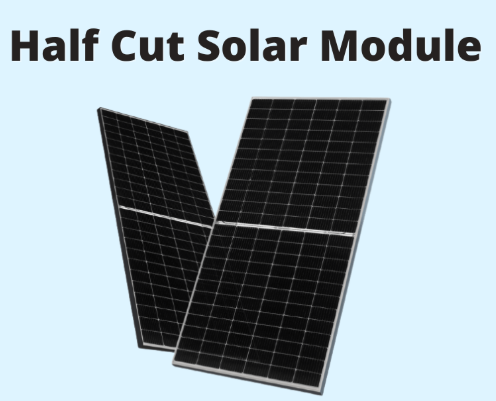Half-cut solar panels represent a significant innovation in photovoltaic design, offering improved efficiency and reliability compared to traditional full-cell panels. These panels utilize solar cells that have been precisely cut in half using advanced diamond wire loop technology, enabling superior performance in real-world conditions. This comprehensive guide explores the technology behind half-cut panels, their manufacturing process, and why they’re becoming the industry standard for modern solar installations.

Half-cut panels maintain the same overall dimensions as traditional panels but feature 120 or 144 half-cells instead of 60 or 72 full cells. These smaller cells are arranged in two separate sections, each operating as an independent panel within the same frame. This innovative design provides several key advantages:
– Reduced Current: Each half-cell carries half the electrical current of a full cell
– Lower Resistance Losses: Electrical losses decrease by a factor of four (P = I²R)
– Independent Operation: Sections function separately, minimizing shading impacts
The cells are typically wired in a parallel-series configuration, where:
– Top and bottom sections operate independently
– Bypass diodes protect each section separately
– Voltage remains similar to conventional panels while current reduces
The performance of half-cut panels depends entirely on the quality of the cell cutting process. Imperfect cuts can lead to:
– Micro-cracks that propagate over time
– Edge defects that reduce efficiency
– Inconsistent cell sizes causing electrical mismatches
Diamond wire loop technology has emerged as the optimal method for creating half-cells because it:
– Maintains dimensional accuracy within ±0.1mm
– Creates clean edges with minimal micro-cracks
– Handles thin wafers (120-160μm) without damage
– Processes thousands of cells per hour
– Maintains consistent quality across production runs
– Reduces material loss through narrow kerf width
– Cold cutting process avoids thermal damage
– Maintains surface passivation layers
– Prevents contamination of cell surfaces
– 5-8% Higher Energy Output: Reduced losses and better shading tolerance
– Improved Temperature Coefficient: Better performance in hot conditions
– Higher Maximum Power Point: Optimized power output across conditions
– Lower Operating Temperatures: Reduced current decreases heat generation
– Better Durability: Smaller cells experience less mechanical stress
– Longer Warranty Periods: Typically 25-30 years performance guarantees
– Partial shading affects only individual sections
– Up to 50% less power loss compared to full-cell panels
– Maintains performance in challenging installation environments
|
Feature |
Half-Cut Panels |
Traditional Panels |
|
Cell Count |
120-144 cells |
60-72 cells |
|
Current Flow |
Half current per cell |
Full current per cell |
|
Shading Impact |
Minimal power loss |
Significant power loss |
|
Efficiency |
19-22% |
17-20% |
|
Cost Premium |
5-15% higher |
Baseline |
Cutting Process Optimization
Modern manufacturing facilities use diamond wire loop systems that feature:
– Automated Tension Control: Maintains consistent wire tension
– Advanced Cooling Systems: Prevents thermal damage to cells
– Real-Time Monitoring: Detects and corrects issues immediately
– Automated optical inspection of every cut cell
– Electroluminescence testing for micro-cracks
– Statistical process control for consistent results
– Residential Roofs: Limited space requiring maximum efficiency
– Commercial Buildings: Shading from surrounding structures
– Snow-Prone Areas: Better performance with partial snow coverage
– High-Temperature Environments: Superior temperature coefficients
– Ensure proper ventilation behind panels
– Use compatible microinverters or optimizers
– Follow manufacturer’s specific installation guidelines
– Thinner Wafers: Progress toward 100μm thickness
– Larger Formats: Transition to M10 and G12 cell sizes
– Integrated Technologies: Combination with bifacial and PERC technologies
– AI-Powered Optimization: Machine learning for process improvement
– Sustainable Production: Reduced water and energy consumption
– Circular Economy: Recycling of silicon and cutting materials
Why Choose Half-Cut Solar Panels?
Half-cut technology offers compelling benefits for most solar applications:
– Higher Energy Yield: More power from the same roof space
– Better Reliability: Proven long-term performance
– Improved Shading Performance: Consistent output in imperfect conditions
– Future-Proof Technology: Compatibility with evolving system designs
The precision made possible by diamond wire loop cutting technology ensures that these theoretical advantages translate into real-world performance benefits.
Half-cut solar panels represent more than just an incremental improvement in solar technology. They demonstrate how manufacturing precision—enabled by advanced diamond wire loop cutting systems—can create products that outperform conventional designs in virtually every metric.
As manufacturing costs continue to decrease and efficiency improves, half-cut technology is rapidly becoming the new standard for quality solar installations. For homeowners, businesses, and utility-scale developers, these panels offer the perfect balance of performance, reliability, and value.
If you have any question, please contact us